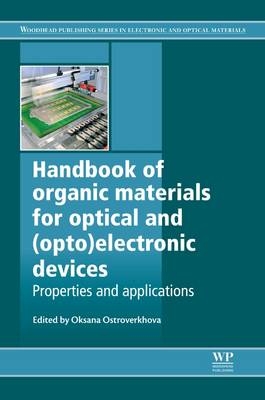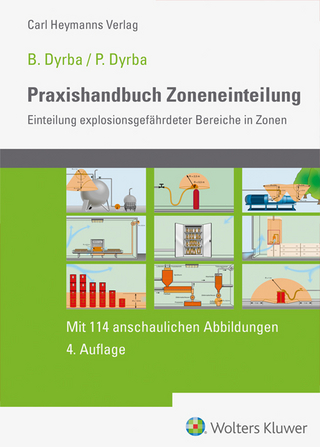
Handbook of Organic Materials for Optical and (Opto)Electronic Devices
Woodhead Publishing Ltd (Verlag)
978-0-85709-265-6 (ISBN)
- Titel erscheint in neuer Auflage
- Artikel merken
Small molecules and conjugated polymers, the two main types of organic materials used for optoelectronic and photonic devices, can be used in a number of applications including organic light-emitting diodes, photovoltaic devices, photorefractive devices and waveguides. Organic materials are attractive due to their low cost, the possibility of their deposition from solution onto large-area substrates, and the ability to tailor their properties. The Handbook of organic materials for optical and (opto)electronic devices provides an overview of the properties of organic optoelectronic and nonlinear optical materials, and explains how these materials can be used across a range of applications.Parts one and two explore the materials used for organic optoelectronics and nonlinear optics, their properties, and methods of their characterization illustrated by physical studies. Part three moves on to discuss the applications of optoelectronic and nonlinear optical organic materials in devices and includes chapters on organic solar cells, electronic memory devices, and electronic chemical sensors, electro-optic devices.The Handbook of organic materials for optical and (opto)electronic devices is a technical resource for physicists, chemists, electrical engineers and materials scientists involved in research and development of organic semiconductor and nonlinear optical materials and devices.
Oksana Ostroverkhova is Professor in Physics at the Department of Physics, Oregon State University, USA.
Contributor contact details
Woodhead Publishing Series in Electronic and Optical Materials
Preface
Chapter 1: Small molecular weight materials for (opto)electronic applications: overview
Abstract:
1.1 Introduction
1.2 Historical development in organic (opto)electronics: devices and materials
1.3 Photo and electroactive organic materials: organic π-electron systems
1.4 Organic (opto)electronic devices: principles and operation processes
1.5 Molecular materials for organic (opto)electronic devices
1.6 Structures and performance of organic (opto)electronic devices
1.7 Conclusion and future trends
Chapter 2: Influence of film morphology on optical and electronic properties of organic materials
Abstract:
2.1 Introduction
2.2 Discontinuous processing
2.3 Continuous processing
2.4 Conclusion
Chapter 3: Doping effects on charge transport in organic materials
Abstract:
3.1 Introduction
3.2 Basics of doping of organic semiconductors
3.3 Doped organic p-i-n devices
3.4 Conclusion and future trends
3.5 Acknowledgements
3.7 Appendix: compound abbreviations, full names and CAS numbers
Chapter 4: Third-order nonlinear optical properties of π-conjugated polymers with thiophene units and molecular assembly of the polymers
Abstract:
4.1 Introduction
4.2 Third-order nonlinear optical properties of π-conjugated polymers with thiophene units and related compounds
4.3 Packing and molecular assembly of π-conjugated polymers
4.4 Conclusions and future trends
4.5 Acknowledgments
Chapter 5: Small molecule supramolecular assemblies for thirdorder nonlinear optics
Abstract
5.1 Introduction
5.2 Fundamental principles of the third-order nonlinear optical response
5.3 Macroscopic susceptibilities and microscopic polarizabilities
5.4 From molecules to bulk solid-state materials
5.5 Small molecules with large third-order nonlinearities
5.6 Small molecule supramolecular assemblies with high optical quality and large third-order susceptibility
5.7 Conclusion
Chapter 6: Molecular crystals and crystalline thin films for photonics
Abstract
6.1 Introduction
6.2 Second-order nonlinear optical (NLO) organic crystals
6.3 THz-wave generation and detection with organic crystals
6.4 Integrated electro-optic (EO) applications
6.5 Conclusions and future trends
Chapter 7: Charge generation and transport in organic materials
Abstract:
7.1 Introduction
7.2 Theoretical and computational framework
7.3 Single-molecule magnitudes
7.4 Supramolecular organization of the samples
7.5 Predicting relative and absolute values of mobilities
7.6 From p-type to n-type semiconductors
7.7 Conclusion
7.8 Acknowledgements
Chapter 8: Optical, photoluminescent and electroluminescent properties of organic materials
Abstract:
8.1 Introduction
8.2 Electronic states of single molecule and molecular solid state
8.3 Absorption and emission spectroscopy
8.4 Excitonic processes
8.5 Electroluminescence in organic materials
8.6 Conclusion and future trends
Chapter 9: Nonlinear optical properties of organic materials
Abstract
9.1 Introduction
9.2 Nonlinear optics (NLO) at the molecular level
9.3 From microscopic (molecules) to macroscopic (materials)
9.4 Quantum mechanical expressions for the molecular (hyper)polarizabilities
9.5 Conclusion and future trends
Chapter 10: Ultrafast intrachain exciton dynamics in π-conjugated polymers
Abstract:
10.1 Introduction
10.2 Ultrafast dynamics in π-conjugated polymers
10.3 Conclusion
Chapter 11: Ultrafast charge carrier dynamics in organic (opto)electronic materials
Abstract
11.1 Introduction
11.2 Infrared-active vibrational (IRAV) modes
11.3 Transient photocurrent (TPC) spectroscopy
11.4 Time-resolved terahertz spectroscopy (TRTS)
11.5 Time-resolved microwave conductivity (TRMC)
11.6 Experimental evidence of charge localization
11.7 Conclusion
Chapter 12: Short-pulse induced photocurrent and photoluminescence in organic materials
Abstract
12.1 Introduction
12.2 Photocurrent response after short pulse excitation
12.3 Exciton dynamics and photoluminescence in organic molecular crystals
12.4 Exciton dynamics and delayed photocurrent
12.5 Conclusion
Chapter 13: Conductivity measurements of organic materials using field-effect transistors (FETs) and space-charge-limited current (SCLC) technique
Abstract:
13.1 Introduction
13.2 Field-effect transistor (FET) measurements
13.3 Space-charge-limited current (SCLC) measurements
13.4 Future trends
Chapter 14: Charge transport features in disordered organic materials measured by time-of-fl ight (TOF), xerographic discharge (XTOF) and charge extraction by linearly increasing voltage (CELIV) techniques
Abstract:
14.1 Introduction
14.2 Measurement techniques
14.3 Experimental results of charge carrier mobility determination
14.4 Charge transport models in disordered organic semiconductors
14.5 Conclusion
Chapter 15: Surface enhanced Raman scattering (SERS) characterization of metal–organic interactions
Abstract
15.1 Introduction
15.2 Surface enhanced Raman scattering (SERS) background
15.3 Surface enhanced Raman scattering (SERS) applications
15.4 Active and passive control of surface enhanced Raman scattering (SERS) signals
15.5 Conclusion
Chapter 16: Second harmonic generation (SHG) as a characterization technique and phenomological probe for organic materials
16.1 Introduction
16.2 Second harmonic generation (SHG) in bulk media
16.3 Electric field induced second harmonic generation (EFISHG)
16.4 Hyper-Rayleigh scattering (HRS)
16.5 Second harmonic generation (SHG) probing structure and dynamics
16.6 Conclusion
16.7 Acknowledgments
Chapter 17: Organic solar cells (OSCs)
Abstract
17.1 Introduction
17.2 Organic solar cells (OSCs)
17.3 Working principle and device structures
17.4 Materials
17.5 Roll-to-roll (R2R) processing of organic solar cells (OSCs)
17.6 Demonstration projects and conclusion
17.7 Acknowledgments
Chapter 18: Organic light-emitting diodes (OLEDs)
Abstract
18.1 Introduction
18.2 Basics of organic light-emitting diodes (OLEDs)
18.3 Pin organic light-emitting diodes (OLEDs)
18.4 Highly efficient monochrome organic light-emitting diodes (OLEDs)
18.5 Highly efficient white organic light-emitting diodes (OLEDs)
18.6 Degradation of organic light-emitting diodes (OLEDs)
18.7 Future trends
Chapter 19: Organic spintronics
Abstract
19.1 Introduction
19.2 Magneto-conductance (MC) and magneto-electroluminescence (MEL) in organic light-emitting diodes (OLEDs)
19.3 Organic spin-valves (OSVs)
19.4 Optically detected magnetic resonance (ODMR) in poly (dioctyloxy) phenyl vinylene (DOO-PPV) isotopes
19.5 Conclusion
19.6 Acknowledgments
Chapter 20: Organic semiconductors (OSCs) for electronic chemical sensors
Abstract
20.1 Introduction to organic semiconductors (OSCs)
20.2 Sensitive organic semiconductor (OSC) devices
20.3 Sensitive carbon nanotube and graphene devices
20.4 Conclusion
20.5 Acknowledgments
Chapter 21: Organic bioelectronics
Abstract:
21.1 Introduction to organic bioelectronics
21.2 Organic electrochemical transistors (OECTs)
21.3 Enzymatic sensing with organic electrochemical transistors (OECTs)
21.4 Cell-based organic electrochemical transistors (OECTs)
21.5 Conclusions and future trends
Chapter 22: Organic electronic memory devices
Abstract
22.1 Introduction
22.2 Memory types
22.3 Resistive memory
22.4 Organic flash memory
22.5 Ferroelectric random access memory (RAM)
22.6 Molecular memories
22.7 Future trends
22.8 Sources of further information
22.9 Acknowledgement
Chapter 23: Unconventional molecular scale logic devices
Abstract:
23.1 Introduction
23.2 Properties of nanoparticles and their applications in molecular scale logic devices
23.3 Photoelectrochemical photocurrent switching (PEPS) effect
23.4 Logic devices based on photoelectrochemical photocurrent switching (PEPS) effect
23.5 Conclusions and future trends
23.6 Acknowledgments
Chapter 24: Photorefractive (PR) polymers and their recent applications
Abstract:
24.1 Introduction
24.2 Fundamentals of photorefractivity
24.3 Functions of photorefractive (PR) components
24.4 Photorefractive (PR) characterization techniques
24.5 Photorefractive (PR) polymer composites for applications
24.6 Conclusion and future trends
Chapter 25: Organic waveguides, ultra-low loss demultiplexers and electro-optic (EO) polymer devices
Abstract:
25.1 Introduction and motivation for using polymer (opto)electronic components
25.2 General polymer science
25.3 Polymer processing
25.4 Ultra-low loss polymer waveguide devices: materials science
25.5 Ultra-low loss polymer waveguide fabrication and process-induced losses
25.6 Perfluoropolymer-based true time delay (TTD) modules
25.7 Wide band channelizer with high-resolution arrayed waveguide grating (AWG)
25.8 Electro-optical polymer-based waveguide devices: materials science
25.9 Molecular theory of electro-optic (EO) polymers
25.10 Electric-field assisted poling in polymer films
25.11 Device and system level analysis for electro-optical polymer waveguides
25.12 Electro-optic (EO) polymer spatial light modulators: theory
25.13 Spacial light modulator device design and fabrication
25.14 Spacial light modulator device characterization
25.15 Future design considerations for spatial light modulators
25.16 Conclusion
Index
| Reihe/Serie | Woodhead Publishing Series in Electronic and Optical Materials |
|---|---|
| Verlagsort | Cambridge |
| Sprache | englisch |
| Maße | 156 x 234 mm |
| Gewicht | 1380 g |
| Themenwelt | Technik |
| ISBN-10 | 0-85709-265-0 / 0857092650 |
| ISBN-13 | 978-0-85709-265-6 / 9780857092656 |
| Zustand | Neuware |
| Haben Sie eine Frage zum Produkt? |
aus dem Bereich



